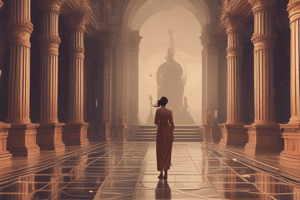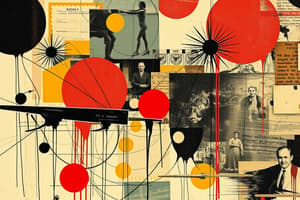Podcast
Questions and Answers
What is aesthetics?
What is aesthetics?
The study of what is beautiful, significant, or interesting in the visual arts
What defines representational art?
What defines representational art?
Works that depict objects we recognize from the everyday world
What is abstract art?
What is abstract art?
Works that depict objects in simplified, distorted, or exaggerated ways
What characterizes non-objective art?
What characterizes non-objective art?
What does iconography refer to in art?
What does iconography refer to in art?
What are geometric shapes?
What are geometric shapes?
What defines organic shapes?
What defines organic shapes?
What is atmospheric perspective?
What is atmospheric perspective?
What is isometric perspective?
What is isometric perspective?
What is linear perspective?
What is linear perspective?
What does the term value refer to in art?
What does the term value refer to in art?
What are primary colors?
What are primary colors?
What are secondary colors?
What are secondary colors?
What are complementary colors?
What are complementary colors?
What is unity in art?
What is unity in art?
What is variety in art?
What is variety in art?
What is symmetrical balance?
What is symmetrical balance?
What does asymmetrical balance mean?
What does asymmetrical balance mean?
What is radial balance?
What is radial balance?
What does monumental scale refer to in art?
What does monumental scale refer to in art?
What is proportion in art?
What is proportion in art?
What does hierarchal scale mean?
What does hierarchal scale mean?
What is emphasis in art?
What is emphasis in art?
What is the focal point in a work?
What is the focal point in a work?
What does pattern refer to in art?
What does pattern refer to in art?
What is contrast in art?
What is contrast in art?
Flashcards are hidden until you start studying
Study Notes
Aesthetics and Art Forms
- Aesthetics involves the exploration of beauty, significance, and intrigue within visual arts.
- Representational art captures recognizable objects from the everyday world.
- Abstract art simplifies or distorts objects, focusing on shapes and colors.
- Non-objective art has no references to real-world objects, emphasizing visual forms alone.
Art Interpretation and Shapes
- Iconography allows objects in artworks to possess meanings beyond their appearance.
- Geometric shapes are precise and regular, rooted in mathematical principles like circles and squares.
- Organic shapes draw inspiration from nature and are often irregular and curving, resembling elements like leaves and animals.
Perspective Techniques
- Atmospheric perspective clarifies foreground objects while blurring those in the background.
- Isometric perspective depicts tilted objects where lower ground elements appear closer than upper ground ones.
- Linear perspective creates depth through parallel lines converging at a vanishing point on the horizon.
Color Theory
- Value refers to the lightness or darkness of colors within an artwork.
- Primary colors include red, yellow, and blue; these are the foundation for creating other colors.
- Secondary colors result from mixing primary colors: red + yellow = orange, red + blue = purple, yellow + blue = green.
- Complementary colors are pairs that enhance each other, such as red and green, yellow and purple, blue and orange.
Principles of Design
- Unity conveys a sense of oneness throughout the artwork, creating harmony.
- Variety introduces interest through contrasting elements within the composition.
- Symmetrical balance creates visual equivalence on either side of the artwork.
- Asymmetrical balance presents uneven visual weight while maintaining overall composition stability.
- Radial balance radiates outward from a central point, distributing visual elements around a focal area.
Scale and Proportions
- Monumental scale represents objects that appear larger than real life.
- Proportion addresses the size relationships between different parts of a work and their connection to the whole.
- Hierarchical scale uses size variations to indicate importance among elements within the artwork.
Emphasis and Focus
- Emphasis directs viewers' attention to specific areas or elements within a work.
- The focal point serves as the center of interest, guiding the viewer’s gaze through the artwork.
Patterns and Contrast
- Patterns feature arrangements of elements that are predictably repeated, creating visual rhythm.
- Contrast highlights differences in color, value, or texture, emphasizing diversity within the artwork.
Studying That Suits You
Use AI to generate personalized quizzes and flashcards to suit your learning preferences.




